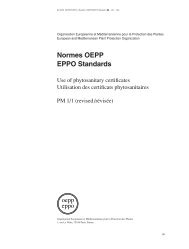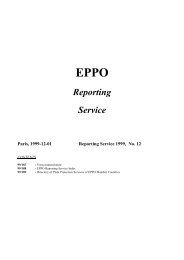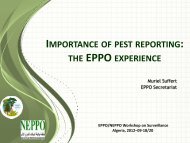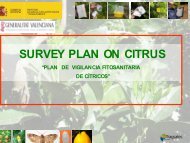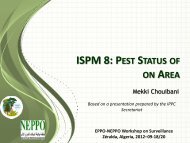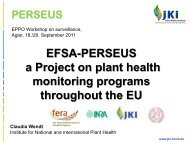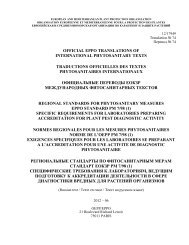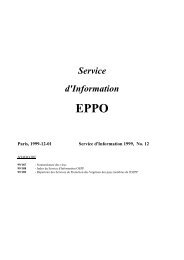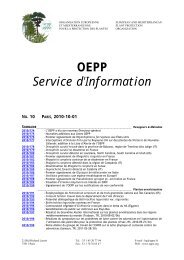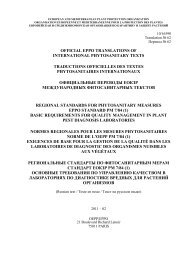EPPO Reporting Service - Lists of EPPO Standards - European and ...
EPPO Reporting Service - Lists of EPPO Standards - European and ...
EPPO Reporting Service - Lists of EPPO Standards - European and ...
You also want an ePaper? Increase the reach of your titles
YUMPU automatically turns print PDFs into web optimized ePapers that Google loves.
<strong>EPPO</strong> <strong>Reporting</strong> <strong>Service</strong> – Pests & Diseases<br />
2011/037 First report <strong>of</strong> Strauzia longipennis in Germany: addition to the <strong>EPPO</strong><br />
Alert List<br />
The NPPO <strong>of</strong> Germany recently informed the <strong>EPPO</strong> Secretariat <strong>of</strong> the first record <strong>of</strong><br />
Strauzia longipennis (Diptera: Tephritidae – sunflower maggot) on its territory, which also<br />
represents a first record for Europe. In June 2010, S. longipennis was found on a single<br />
sunflower plant (Helianthus annuus) in a private garden in Berlin (locality <strong>of</strong> Johannisthal<br />
in the Berlin borough <strong>of</strong> Treptow-Köpenick). This sunflower plant did not show external<br />
symptoms, but two female flies were observed walking on the leaves <strong>and</strong> ovipositing in the<br />
stem. Three other findings were made in 2010 in Berlin, in the localities <strong>of</strong> Wartemberg,<br />
Lankwitz <strong>and</strong> Tempelh<strong>of</strong> (boroughs <strong>of</strong> Lichtenberg, Steglitz-Zehlendorf, Tempelh<strong>of</strong>-<br />
Schöneberg, respectively). Investigations suggested that S. longipennis has probably been<br />
present since 2008 in Berlin. The Regional Plant Protection <strong>Service</strong> will carry out a survey<br />
in 2011 at the locations where the pest has been recorded. A rapid PRA conducted by the<br />
NPPO suggested that S. longipennis could represent a medium risk for Germany. Further<br />
more, considering the importance <strong>of</strong> sunflower cultivation in the <strong>EPPO</strong> region, the German<br />
NPPO suggested that S. longipennis should be added to the <strong>EPPO</strong> Alert List.<br />
Strauzia longipennis (Diptera: Tephritidae – Sunflower maggot)<br />
Why An isolated finding <strong>of</strong> Strauzia longipennis, a North American pest <strong>of</strong> sunflowers,<br />
was reported in 2010 from Germany. Considering the importance <strong>of</strong> sunflower<br />
(Helianthus annuus) cultivation in the <strong>EPPO</strong> region, the German NPPO suggested<br />
that S. longipennis should be added to the <strong>EPPO</strong> Alert List.<br />
Where S. longipennis is a North American species which had not been reported outside<br />
its native area, so far.<br />
<strong>EPPO</strong> region: Germany (incursions detected in 2010 in Berlin).<br />
North America: Canada (Alberta, Manitoba, Ontario, <strong>and</strong> possibly other<br />
provinces), USA (Arizona, California, Colorado, Connecticut, Florida (not<br />
established), Idaho, Illinois, Indiana, Iowa, Kansas, Massachusetts, Michigan,<br />
Minnesota, Mississippi, Missouri, Montana, Nebraska, New Jersey, New Mexico,<br />
New York, North Carolina, North Dakota, Ohio, Oregon, Pennsylvania, South<br />
Dakota, Texas, Utah, Virginia, Wisconsin).<br />
On which plants Helianthus annuus (sunflower), <strong>and</strong> other Helianthus species such as H.<br />
maximilianii <strong>and</strong> H. tuberosus (Jerusalem artichoke). S. longipennis has also<br />
been observed on other Asteraceae (e.g. Ageratina altissima, Ambrosia trifida,<br />
Smallanthus uvedalia). S. longipennis is a morphologically variable species <strong>and</strong><br />
its taxonomy is still uncertain (several varieties have been proposed <strong>and</strong> some<br />
elevated to species rank although this is still being debated). Recent studies have<br />
suggested that S. longipennis might be a complex <strong>of</strong> host-associated populations<br />
that are in the process <strong>of</strong> divergence (incipient species).<br />
Damage Larvae <strong>of</strong> S. longipennis bore tunnels in the pith <strong>of</strong> sunflower stalks. Depending<br />
on the number <strong>of</strong> larvae, injury may vary from a short tunnel to complete<br />
destruction <strong>of</strong> the pith. Large infestations can weaken the stalk <strong>and</strong> eventually<br />
lead to plant breakage. Secondary fungal infections (e.g. Sclerotinia) can be<br />
associated with larval feeding inside the stalk. However, in the major sunflowerproducing<br />
regions <strong>of</strong> North America (North <strong>and</strong> South Dakota, Minnesota <strong>and</strong><br />
Manitoba), S. longipennis is usually considered as a minor pest. Even when high<br />
percentages <strong>of</strong> plants are infested, larval feeding is confined to the pith, which<br />
acts a supporting structure <strong>and</strong> is not critical for plant nutrition. Studies carried<br />
out in the 1950s in Manitoba (CA) in fields where a high percentage <strong>of</strong> sunflower<br />
plants were infested concluded that feeding damage caused by larvae to the pith<br />
<strong>of</strong> the sunflower stalk had no apparent affect on head diameter, seed yield <strong>and</strong><br />
quality.<br />
Adults <strong>of</strong> S. longipennis are showy yellow tephritid flies (body length around 6<br />
mm, wingspan <strong>of</strong> 13 mm) with bright green eyes. Wings have dark brown b<strong>and</strong>s<br />
8




